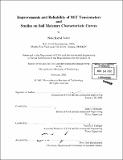| dc.contributor.advisor | John T. Germaine and Patricia J. Culligan. | en_US |
| dc.contributor.author | Toker, Nabi Kartal, 1979- | en_US |
| dc.contributor.other | Massachusetts Institute of Technology. Dept. of Civil and Environmental Engineering. | en_US |
| dc.date.accessioned | 2005-09-06T20:41:09Z | |
| dc.date.available | 2005-09-06T20:41:09Z | |
| dc.date.copyright | 2002 | en_US |
| dc.date.issued | 2002 | en_US |
| dc.identifier.uri | http://hdl.handle.net/1721.1/26891 | |
| dc.description | Thesis (S.M.)--Massachusetts Institute of Technology, Dept. of Civil and Environmental Engineering, 2002. | en_US |
| dc.description | Includes bibliographical references (p. 141-143). | en_US |
| dc.description.abstract | Soil Moisture Characteristic (SMC) curves are widely used in unsaturated soil mechanics and agricultural engineering. A SMC curve is the relation between the soil suction (tension in the pore water) and the water content (ratio of amount of water to solid particles, preferably by mass). Until now, the methods used to obtain the SMC have involved obtaining point measurements along the SMC curve, which can take weeks to gather, and then fitting a curve through these points. Recently at MIT, a much faster technique for obtaining a complete, continuous SMC curve has been developed. A digital laboratory balance and an MIT tensiometer, both monitored by a data acquisition computer, obtain continuous water content and soil suction data, respectively. As any other invention, advantages, disadvantages, and limitations of this device and technique need to be assessed and improved. Along the course of this research, some of these assessments or improvements were made, while attempting to extend a correlation developed recently at MIT, as well as to understand the effect of the grain size distribution on the SMC. While measurement capacity of the tensiometer was not improved, the latest version is significantly more serviceable than its predecessors. Although intended, it has not been possible to compare the tensiometer readings to theoretically induced suction values by relative humidity of the environment. Only comparative study was by capillary rise tests. Numerous parameters that affect the experiments, such as compaction and heterogeneity of the specimen, data acquisition cables, mass balance sensitivity and temperature of the environment, were discovered and their effects were minimized. The newly repeatable procedure was used to observe grain size distribution effects on the SMC curve, and to correct the past understanding of grain size-SMC relationship, which was based on biased test results for neglecting some of the affecting parameters listed above. | en_US |
| dc.description.statementofresponsibility | by Nabi Kartal Toker. | en_US |
| dc.format.extent | 143 p. | en_US |
| dc.format.extent | 9923173 bytes | |
| dc.format.extent | 9941972 bytes | |
| dc.format.mimetype | application/pdf | |
| dc.format.mimetype | application/pdf | |
| dc.language.iso | en_US | |
| dc.publisher | Massachusetts Institute of Technology | en_US |
| dc.rights | M.I.T. theses are protected by copyright. They may be viewed from this source for any purpose, but reproduction or distribution in any format is prohibited without written permission. See provided URL for inquiries about permission. | en_US |
| dc.rights.uri | http://dspace.mit.edu/handle/1721.1/7582 | |
| dc.subject | Civil and Environmental Engineering. | en_US |
| dc.title | Improvements and reliability of MIT tensiometers and studies on soil moisture characteristic curves | en_US |
| dc.title.alternative | Studies on soil moisture characteristic curves | en_US |
| dc.type | Thesis | en_US |
| dc.description.degree | S.M. | en_US |
| dc.contributor.department | Massachusetts Institute of Technology. Department of Civil and Environmental Engineering | |
| dc.identifier.oclc | 50448392 | en_US |
